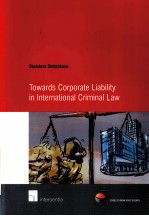

TOWARDS CORPORATE LIABILITY IN INTERNATIONAL CRIMMINAL LAW DESISLAVA STOITCHKOVAPDF电子书下载
- 电子书积分:10 积分如何计算积分?
- 作 者:ANTWERP-OXFORD-PORTLAND
- 出 版 社:INTERSENTIA
- 出版年份:2010
- ISBN:9400000243
- 页数:240 页
1 Introduction 1
Ⅰ Corporations, conflicts and human rights 1
Ⅱ The rise of corporate social responsibility 5
Ⅲ Regulation at the domestic level 7
Ⅲ.1 Criminal liability 7
Ⅲ.2 Liability through civil courts 9
Ⅲ.3 Non-mandatory mechanisms 11
Ⅳ International regulation 12
Ⅳ.1 'Soft-law'initiatives 12
Ⅳ.2 The International Criminal Court 13
Ⅳ.3 Some post-Rome developments 17
Ⅴ Central question 18
Ⅵ Method and structure 20
2 Criminal responsibility and the corporate entity 23
Ⅰ Introduction 23
Ⅱ The criminology of international corporate crime 24
Ⅱ.1 Conceptualising corporate crime 24
Ⅱ.2 Corporate crime in international context 27
Ⅲ The morality paradigm and corporate liability 28
Ⅲ.1 Can corporations be regarded as persons? 29
Ⅲ.2 Moral agency and moral responsibility 30
Ⅲ.3 Legal personhood and moral responsibility 32
Ⅳ Guilt and punishment of collectives 33
Ⅳ.1 The moral guilt contention 35
Ⅳ.2 Collective legal guilt and the position of the individual 36
Ⅳ.3 Accountability, culpability and due process 38
Ⅴ Conclusion 41
3 Corporate accountability a la Nuremberg 43
Ⅰ Introduction 43
Ⅱ The Nuremberg 'collective criminality' model 44
Ⅱ.1 The doctrine of conspiracy 44
Ⅱ.2 The concept of criminal organisations 46
Ⅱ.3 A missed opportunity vis-a-vis corporate accountability? 50
Ⅲ The Nuremberg prosecution of industrialists 53
Ⅲ.1 An overview of domestic military trials 53
Ⅲ.2 Synthesising the Nuremberg principles of individual criminal responsibility in relation to corporate officials 56
Ⅲ.3 The implicit denunciation of corporations as accessories to Nazi crimes 58
Ⅳ The legacy of Nuremberg 61
Ⅴ Conclusion 63
4 Collective criminality and the Rome Statute 65
Ⅰ Introduction 65
Ⅱ The 'common purpose' doctrine 67
Ⅱ.1 Joint criminal enterprise: doctrinal overview 67
Ⅱ.1.1 The elements of joint criminal enterprise as a mode of liability 68
Ⅱ.1.2 Jurisprudential attempts at counteracting the drawbacks of the JCE doctrine 70
Ⅱ.1.2a The customary law origins of JCE 70
Ⅱ.1.2b The inherent complexities of extended JCE 72
Ⅱ.1.2c Critical appraisal of the ad hoc tribunals' approach to JCE 74
Ⅱ.2 The 'common purpose' concept in the Rome Statute 76
Ⅱ.2.1 The divergent nature of Article 25(3)(d) RS 78
Ⅱ.2.2 A redundant provision? 79
Ⅲ The concept of superior responsibility 82
Ⅲ.1 Brief historical survey of the development of the doctrine 8
Ⅲ.2 Superior responsibility under the Rome Statute 83
Ⅲ.2.1 The components of superior responsibility as a mode of liability 84
Ⅲ.2.1a The existence of a superior ?subordinate relationship 85
Ⅲ.2.1b The cognitive requirement for superior responsibility 87
Ⅲ.2.1c Activities within the effective responsibility and control of superiors 89
Ⅲ.2.1d The duty of superiors to act 91
Ⅳ Conclusion 93
5 The criminal liability of corporationswithin the Rome Statute framework 95
Ⅰ Introduction 95
Ⅱ The ambit of actus reus and mens rea in the Rome Statute 96
Ⅱ.1 Acts and omissions 96
Ⅱ.2 The dolus directus facet of Article 30 RS 97
Ⅱ.3 Dolus eventualis as a form of volition? 98
Ⅱ.4 Culpa-type liability under the Rome Statute 101
Ⅲ Utilising the current Rome Statute provisions 102
Ⅲ.1 Indirectly implicating MNCs on the basis of individual convictions 102
Ⅲ.2 The notion of complicity as an avenue for corporate liability 103
Ⅳ Direct corporate criminal liability sui generis 108
Ⅳ.1 The criminal responsibility of corporations 'in the draft' 108
Ⅳ.1.1 Declarations of criminality 109
Ⅳ.1.2 Liability along vicarious lines 110
Ⅳ.2 Domestic approaches to corporate criminal liability 113
Ⅳ.2.1 The principle of aggregation 113
Ⅳ.2.2 Proactive and reactive fault 115
Ⅳ.2.3 The corporate ethos approach 117
Ⅳ.2.4 Constructive corporate fault 118
Ⅳ.3 The constructive method and international crimes 121
Ⅳ.3.1 Setting the subjective threshold of corporate liability 121
Ⅳ.3.1a The dolus eventualis standard of corporate misconduct 122
Ⅳ.3.1b Culpa as a benchmark for corporate criminal responsibility 125
Ⅳ.3.1c A word on dolus specialis 133
Ⅳ.3.2 The scope of the objective element 134
Ⅴ Conclusion 137
6 Culpability beyond the confines of the corporate form 139
Ⅰ Introduction 139
Ⅱ Direct parent liability 140
Ⅱ.1 The intrinsic protections of the corporate form 140
Ⅱ.2 Justifying the attribution of criminal responsibility to parent companies 142
Ⅱ.3 The criteria for ascribing direct liability to parent corporations 143
Ⅱ.3.1 The duty to intervene 146
Ⅱ.3.1a Authority 147
Ⅱ.3.1b Awareness 148
Ⅱ.3.2 The power to intervene 149
Ⅱ.3.2a Control 150
Ⅱ.3.2b Causality 155
Ⅲ Direct criminal responsibility and supply chain dynamics 156
Ⅳ The superior responsibility of corporate officials 159
Ⅳ.1 Superior - subordinate relationships and the 'effective responsibility and control' test 161
Ⅳ.2 The cognitive requirement and the corresponding failure to act 163
Ⅴ Conclusion 165
7 Conclusion 167
Ⅰ Overview 167
Ⅱ Prospects along the regulatory continuum 169
Ⅱ.1 The complementarity contention pertaining to 'inaction' and 'inability' 170
Ⅱ.2 Alternatives to corporate criminal liability and the implications for the principle of complementarity 171
Ⅱ.3 Non-criminal regulation - a viable option for the ICC? 173
Ⅲ The pitfalls of collective criminality 174
Ⅲ.1 The imperative of aligning accountability with due process 176
Ⅲ.2 Collective punishment: effects on the 'innocent' bystander? 179
Ⅳ Liability of MNCs in international criminal law: from aspiration to reality 182
Ⅴ Corporate accountability and the goals of international criminal justice 184
Ⅴ.l The 'problem' of plea bargaining 186
Ⅴ.2 Deterrence, retribution and the expressive function of (international) criminal law 187
Summary 191
Samenvatting 197
Selected legal provisions 205
Bibliography 211
Table of cases 223
Table of UN and other documents 229
Index 231
Curriculum vitae 235
